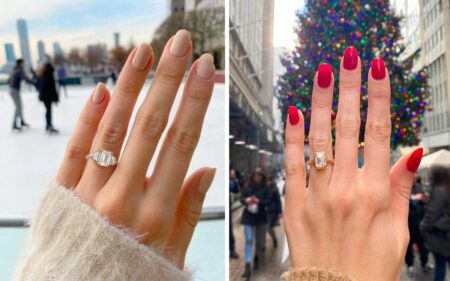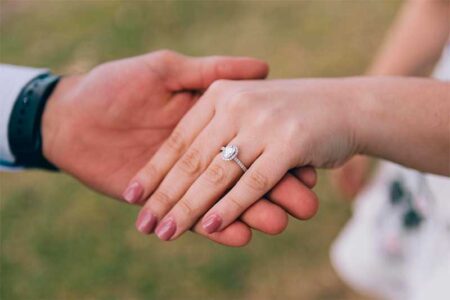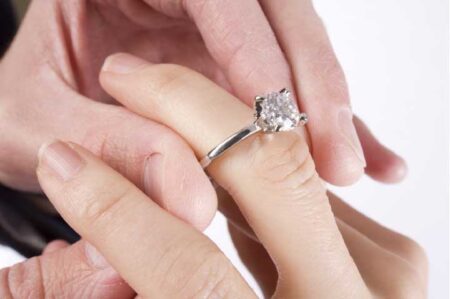Questions to Ask When Shopping for an Antique Engagement Ring
If you’re shopping for an antique or vintage engagement ring, there are a few questions you should ask the vendor before purchasing.

However, if purchasing antique jewelry is a new experience for you, you may want to first understand what makes a ring either antique, vintage, or estate. Find out more here: The Difference Between Antique, Vintage, and Estate Jewelry.
How Old is This Ring?
Even if you have a basic understanding of antique jewelry, sometimes it is difficult to determine the age of the ring. Reproductions can be hard to spot, so make sure you get an antique diamond ring from a reputable dealer like helenstoreyantiques.com. You can then ask what jewelry era the ring is from. A ring from 1895 could be considered either Victorian, Edwardian, or Art Nouveau. If your significant other insists on having an Edwardian ring, ask the dealer to show you different Edwardian options, or better yet have them compare an Edwardian ring with a Victorian one.
Don’t know what a jewelry era is? Learn more here: Most Common Jewelry Eras
Have Any of the Stones Been Replaced?
This isn’t indeed a deal breaker if the engagement ring is not all original. Many of these rings are over 100 years old, so it is to be expected that some form of maintenance has occurred. Dealers usually always try to keep rings original with only necessary repair work, but sometimes this just isn’t possible. Also note that a ring that looks too new with no wear or repairs could be just that, new. If you fiance insists on having an original ring with its original old cut diamonds, then this is very important information to have. Which leads to the next question…
What is the Diamond Cut?
There are a few different antique diamond cuts that are common in the antique engagement rings. If the dealer says a ring from 1910 has a round brilliant cut diamond in it, this is an indicator that the diamond has been replaced. If an engagement ring from the 1940’s has an old European cut diamond in it, this tells you that the diamond which dates to about 1890 or so has been reset in the 1940’s in a more modern setting. There are advantages and disadvantages to having a modern or antique diamond in your ring, and a lot depends on your personal taste.
Does the Ring Come with an Insurance Appraisal?
Insurance appraisals are important because they allow you to acquire jewelry insurance to protect your investment. Most insurance companies won’t add a piece of fine jewelry to your policy without an appraisal. It doesn’t matter whether you get this appraisal from a third party or the dealer you are purchasing from so long as that dealer actively writes jewelry appraisals that are accepted by insurance companies. If they don’t write appraisals, this isn’t necessarily a deal breaker. You can always acquire an appraisal from a different source, which I highly recommend doing. In the meantime, just be sure that the dealer you are purchasing from is a reputable one.
What is your Return Policy?
Not only should you have a good idea as to the jeweler’s return policy, but you should also know if the dealer offers any kind of warranty on the ring. Most antique diamond rings are sold “as-is” which means there is little to no warranty on the ring. This is why acquiring jewelry insurance is so important! You want a dealer to stand behind the authenticity of the diamond ring you are purchasing, but you also need to remember that antique jewelry and any fine jewelry for that matter is not indestructible so proper care should be taken as not to damage your heirloom.
Vintage Rings | Engagement Ring Guide
What is Estate Jewelry and How Does That Differ From Antique and Vintage Jewelry?
The terms antique, vintage, and estate are used to help date older pieces of fine jewelry. So what then makes a piece of jewelry antique? This is one of the most common questions in the antique jewelry industry, and the answer varies from how we would classify cars or houses. All the jewelry that is not brand new is technically considered estate, but not all estate jewelry is considered vintage. Just like all antique jewelry is considered vintage, yet not all vintage jewelry is considered antique. Confusing? Check out this timeline chart for further clarification.
Instead, a reliable dealer would only use the words “antique cameo” to avoid any confusion. An unreliable dealer might call a brand new reproduction cameo that looks very much like the 300-year-old cameo an “estate cameo” to make the uneducated customer believe the cameo is much older than it actually is.
- Estate Jewelry
Jewelry Eras Included in Estate Jewelry: Contemporary
- Vintage Jewelry
Jewelry Eras Included in Vintage Jewelry: Modern, Mid Century Modern, Retro, Art Deco
- Antique Jewelry
Jewelry Eras Included in Antique Jewelry: Art Deco, Edwardian, Belle Epoque, Art Nouveau, Victorian, Georgian, & Earlier





